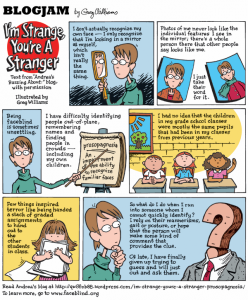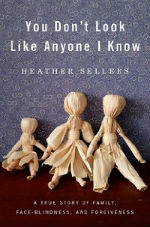
What Is Face-Blindness?
One day, I met the friend of a friend at an indoor play area, and we swapped stories of our sons’ diagnosis and therapies. The other mom was really struggling with her son’s recent diagnosis, and she was asking me some very pointed and personal questions about my son’s development, in the curious way that special needs parents sometimes befriend each other. At one point her son ran up to a stranger, started hugging her and signing for food.
“It happens all the time,” the boy's mother admitted. “He knows me by my shape, not by my face. When his grandmother babysits, she says he doesn’t even notice that I’m gone.” Without considering the emotional impact of my words, I blurted out, “Oh, does he have face-blindness?” My friend answered with surprise and sadness, “I don’t know.”
Prosopagnosia
Everyone has occasional problems matching up faces and names. Face-blindness is the inability to recognize individual faces, even faces of close family members, or in severe cases, one’s own face. The medical term for face-blindness is prosopagnosia, a Greek word meaning “a lack of recognition of a face.” Cases of prosopagnosia have been documented since ancient times. It is one of the most common neurological impairments, affecting up to 2.5% of the general population.
Types of Face-Blindness
[caption id="attachment_10194" align="alignright" width="248"] Click To Enlarge: Graphic Credit: Greg Williams[/caption] There are different types and causes of face-blindness. Most of the published cases involve face-blindness that is acquired after a traumatic brain injury, brain tumor or onset of Alzheimer’s disease. In these cases, the affected individuals know that they were previously able to recognize faces, and it is often a shock to lose this ability. Apperceptive Face-blindness In apperceptive face-blindness, individuals do not understand how to interpret faces at all, and may be unable to say whether two faces are similar or different. Associative Face-blindness In associative face-blindness, individuals can usually say whether two faces are similar or different, and may even identify an acquaintance’s age or sex based on the face alone, but still can’t provide information such as name, occupation or when they last saw the person. Developmental Face-blindness Developmental face-blindness is a lifelong condition not caused by brain injury or disease. The affected person has no memory of being able to recognize faces. This type of face-blindness can run in families, and it is sometimes associated with nonverbal learning disorder and autism. Individuals with developmental face-blindness have difficulty with social skills, because everyone appears to be a stranger, and have trouble following the plots of movies and television shows, because all of the characters’ faces look the same. Children with face-blindness gravitate toward cartoons because each character wears a unique costume.
Click To Enlarge: Graphic Credit: Greg Williams[/caption] There are different types and causes of face-blindness. Most of the published cases involve face-blindness that is acquired after a traumatic brain injury, brain tumor or onset of Alzheimer’s disease. In these cases, the affected individuals know that they were previously able to recognize faces, and it is often a shock to lose this ability. Apperceptive Face-blindness In apperceptive face-blindness, individuals do not understand how to interpret faces at all, and may be unable to say whether two faces are similar or different. Associative Face-blindness In associative face-blindness, individuals can usually say whether two faces are similar or different, and may even identify an acquaintance’s age or sex based on the face alone, but still can’t provide information such as name, occupation or when they last saw the person. Developmental Face-blindness Developmental face-blindness is a lifelong condition not caused by brain injury or disease. The affected person has no memory of being able to recognize faces. This type of face-blindness can run in families, and it is sometimes associated with nonverbal learning disorder and autism. Individuals with developmental face-blindness have difficulty with social skills, because everyone appears to be a stranger, and have trouble following the plots of movies and television shows, because all of the characters’ faces look the same. Children with face-blindness gravitate toward cartoons because each character wears a unique costume.
Compensation Strategies
 Neurologist Oliver Sacks, who has prosopagnosia, recalls being unable to identify his brothers and sometimes not recognizing his own face in the mirror. Author Heather Sellers writes in her memoir about greeting her boyfriend with a kiss, only to realize that she had just kissed a stranger. These adults and others point out that facial recognition cannot be taught - it is a conscious and unconscious process in the occipito-temporal lobe and fusiform gyrus of the human brain. But other recognition strategies can partially compensate for the inability to recognize faces. For example, it is possible to recognize most people by their movements, their hair, their voices, their cars, their habits, their jewelry, their clothing or even their tattoos. Cataloging the facts about a person - “Aunt Maggie talks with a Texan accent and likes to wear purple” or “We always see Mrs. Cohen on Saturday morning” - can speed up the recognition process. Another way to aid recognition is to stick with formal conversational etiquette. Start with introductions and use names often. Insert identifying features into the conversation such as, “I always wear the watch that my parents gave me for my college graduation” or “I’m usually the tallest person in the room.”
Neurologist Oliver Sacks, who has prosopagnosia, recalls being unable to identify his brothers and sometimes not recognizing his own face in the mirror. Author Heather Sellers writes in her memoir about greeting her boyfriend with a kiss, only to realize that she had just kissed a stranger. These adults and others point out that facial recognition cannot be taught - it is a conscious and unconscious process in the occipito-temporal lobe and fusiform gyrus of the human brain. But other recognition strategies can partially compensate for the inability to recognize faces. For example, it is possible to recognize most people by their movements, their hair, their voices, their cars, their habits, their jewelry, their clothing or even their tattoos. Cataloging the facts about a person - “Aunt Maggie talks with a Texan accent and likes to wear purple” or “We always see Mrs. Cohen on Saturday morning” - can speed up the recognition process. Another way to aid recognition is to stick with formal conversational etiquette. Start with introductions and use names often. Insert identifying features into the conversation such as, “I always wear the watch that my parents gave me for my college graduation” or “I’m usually the tallest person in the room.”
Face-Blindness or Synesthesia?
Some conditions may be mistaken for face-blindness. I have a family member who can easily identify faces but avoids looking at them because it gives her physical pain. This is actually a type of synesthesia, when one type of sensory input is interpreted by the brain as a different type of sensory input. Looking at faces may trigger a variety of sensory experiences, including music, fragrance, light or color, and even tactile sensations.
Emotion Recognition
The inability to recognize emotions is also sometimes confused with face-blindness. Most people with face-blindness are able to recognize emotions based on facial expressions, but it is possible for a person to have difficulty recognizing both faces and emotions. Difficulty with emotion recognition is a separate neurological condition usually associated with Post-Traumatic Stress Disorder, autism, traumatic brain injury and schizophrenia. Results from scientific studies have been mixed, some finding no difference in emotion recognition between typical and autistic adults, others finding a significant impairment in recognition of the most subtle and complex emotions among individuals with known neurological conditions. In my son’s case, I know that he can identify the emotions on my face, but he has difficulty identifying the emotions that he is experiencing. Emotion recognition can be taught, but again, the results of scientific studies have been mixed. Next week I’ll review some of the tools now available to teach emotions to students with special needs.
Face Blindness on 60 Minutes
Last year 60 Minutes reported on face-blindness. Watch the video below to get a better understanding of the challenges of Face-blindness. [youtube=http://www.youtube.com/watch?v=dxqsBk7Wn-Y&rel=0] [youtube=http://www.youtube.com/watch?v=q8cXus7SNQY&rel=0]



